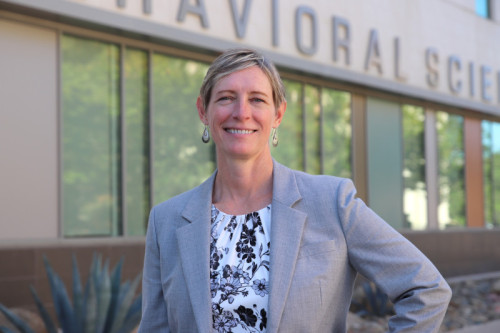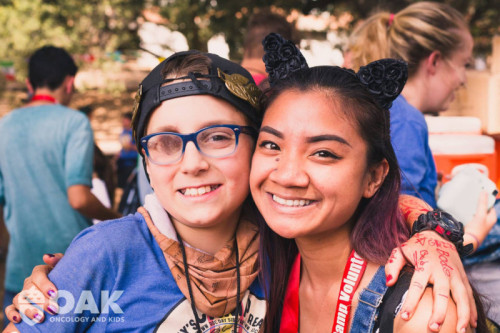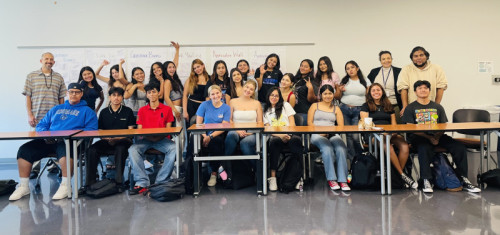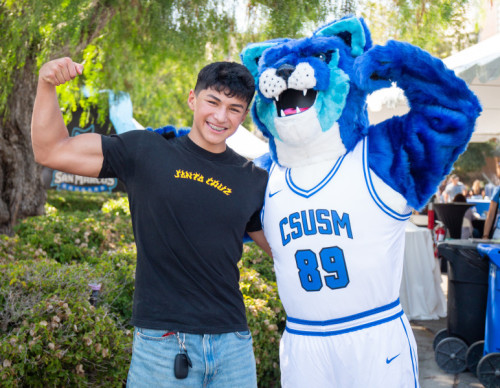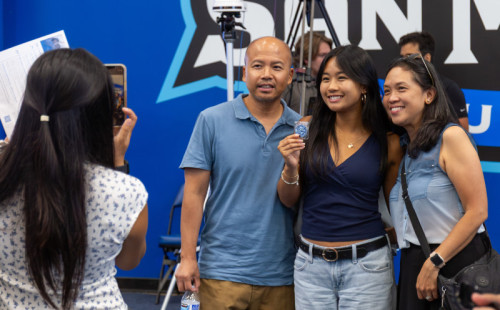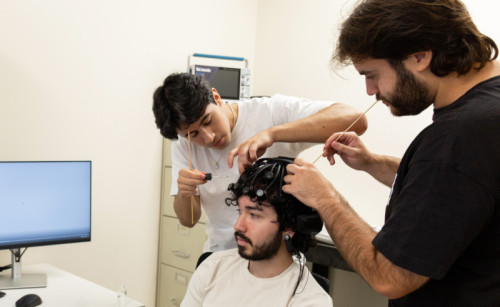Grandmother's Care Inspires Nursing Student
Latest Newsroom
- New CHABSS Tenure-Track Faculty Drawn to CSUSM For Myriad ReasonsTeaching in a student population environment of around 2,500 and then moving to one with 17,000+ is one of the many challenges Roni Kay O’Dell, a new assistant professor of political science and global affairs, has signed up for this semester. “I’m really impressed with high student participation in my classes,” said O’Dell, who is particularly moved by the contributions of her global governance class, which is essentially an introduction to international relations. “I’m really excited that the students are so interested in the subject matter. We’ve also already had some really good conversations about current events that are happening in my environmental politics class, which is called Green Planet Politics.” O’Dell is one of four newly hired tenure-track faculty in the College of Humanities, Arts, Behavioral and Social Sciences. She is spending this week at the University of Bradford in the United Kingdom at the Human Development and Capability Association Conference where she will present her research on how humans can agree on sustainable use and management of Earth’s resources. O’Dell is also a board member (director at large) for the organization. O’Dell comes to CSUSM from Seton Hill University, a private Catholic liberal arts university in Greensburg, Penn. There, she was program coordinator (essentially the chair) of the political science and global studies program, led the Model United Nations program and was the adviser for the Pi Sigma Alpha National Political Science Honor’s Society chapter. In addition to the larger student population here, another adjustment she has enjoyed is the change in lifestyle. Along with her husband and dog, O’Dell has already basked in beach days and local hikes, including traversing Torrey Pines recently. “There are a lot of wonderful things about where I’ve lived before, but there’s nothing like being able to go for a walk on the ocean so easily, or be on the beach or even do some of the hikes around here and enjoy the beautiful views,” said O’Dell, who grew up in Montana and earned her bachelor’s degree from the University of Washington, her master’s from the Middlebury Institute of International Studies at Monterey and her Ph.D. from the University of Denver. O’Dell is not unlike many CSUSM students. She was the first in her family to graduate from college, beginning that journey at the community college level. Social mobility was a crucial part of her path so she’s excited to help guide students here by utilizing the same tools of hard work and a caring support system. “I know that CSUSM has that amazing opportunity for students, and so many people who come here are the first people in their family who have gone to a college or are thinking about a university degree or thinking about expanding what they want to do with their lives,” she said. “That was one of the things that definitely drew me.” O’Dell wants to support students to learn and practice how to protect the environment. Essentially, how to make sure humans can thrive while also utilizing our resources sustainably. Putting the theoretical into practice. “There are so many ways CSUSM focuses on sustainability, on the concern for the environment,” she said. “That’s deeply connected to my study of public policy, my study of international relations — my academic interests and research interests — but also practical interests. So that’s really exciting.” Hyunjin Koo Hyunjin Koo is an assistant professor in the department of psychological science. She earned her Ph.D. in social psychology from UC Irvine, and worked as a postdoctoral research associate at the University of British Columbia before joining CSUSM. As a social psychologist, Koo has two main research programs. First, her work examines how experiences and beliefs about socioeconomic mobility shape everyday thoughts and behaviors, including attitudes toward work and leisure, views of the rich and poor, perceptions of inequality, morality, and social class. Second, in an emerging line of research, she studies a novel psychological construct she and her team have introduced — leisure guilt — which refers to the guilt people feel when taking leisure time instead of being productive. Her research explores the antecedents and consequences of leisure guilt, as well as the cultural and social factors that influence it. What drew you to CSUSM? Koo: I was drawn to CSUSM for its strong commitment to student success and social mobility. My main research interest is social mobility, so I was excited to find that my work aligns perfectly with the university’s mission and goals. What are you hoping your students will take away from your classes? Koo: I hope that through my classes, students come to see how psychology connects to many aspects of their daily lives and experiences, and that they discover the joy of engaging with psychological topics. What is one of your professional goals you hope to accomplish while you’re here? Koo: I want to embody the teacher–scholar model. My goal is to be both a strong researcher and a dedicated teacher who helps students achieve their own success. What is your favorite activity during your downtime? In my free time, I enjoy exploring new coffee shops and restaurants and finding new favorites. I’m especially excited that San Diego has so many places to discover! Kiana Maillet Kiana Maillet is an assistant professor in the American Indian Studies department and is a member of the Lone Pine Paiute-Shoshone Tribe. She is a double CSUSM alumna, a licensed clinical social worker with multiple certifications and has extensive volunteer and work experience working with youth, families and communities. Her research interests include American Indian experiences within systems such as foster care, schools and mental health as well as traditional teachings and experiences with language, foods, plants, places and ceremony. What drew you to CSUSM? Maillet: I went through the Master of Social Work and the joint doctoral programs at CSUSM and have been a lecturer here for several years in the AIS department. What are you hoping your students will take away from your classes? Maillet: I hope that students will learn about the beauty and complexity of Native ways of being — our side of history, science, mental health, ecology, language, the real impacts of colonization and the strength and resilience of our people. What is one of your professional goals you hope to accomplish while you’re here? Maillet: I hope to not only share my knowledge, but to also continue to grow and learn myself. I want to be able to make a positive impact on our students, our campus and in our communities. What is your favorite activity during your down time? Maillet: I enjoy hiking, gardening, playing with my grandsons and attending our Nüümü Yadoha (Paiute Language) classes. Carlos Rosas Carlos Rosas is a new assistant professor in the psychological science department. He’s also no stranger to campus. Rosas earned his bachelor’s degree in psychology from CSUSM and a Ph.D. in psychology with a concentration in community and prevention research from the University of Illinois Chicago. Rosas completed epidemiology-focused postdoctoral fellowships at UC San Diego and SDSU. For the past two years, he has also taught various classes as a lecturer at CSUSM. His research program integrates social and health psychology theories, epidemiological methods, and community-based participatory research approaches 1) to examine the social, cultural, and psychological drivers/determinants (e.g., SES, immigration status, and racial/ethnic discrimination) of mental and physical health — particularly in the context of chronic disease prevention and management; and 2) to develop, implement, and evaluate culturally informed and tailored, community-based interventions to promote healthy behaviors and mitigate risk factors. His research places special emphasis on communities of color and other historically understudied populations. Rosas regularly teaches multicultural perspectives in psychology, social psychology, and statistics in psychology. What drew you to CSUSM? Rosas: CSUSM is my alma mater. As an undergraduate, I found CSUSM to be an incredibly supportive and intellectually nurturing academic home. The encouragement and guidance I received from the psychology faculty were quite literally life changing. I would not have pursued a doctoral degree without their unwavering support and mentorship. Hence, returning to CSUSM was the natural choice for me, and I'm really excited for the opportunity to provide my own students with the same support, motivation, and inspiration that I once received from my own professors. What are you hoping your students will take away from your classes? Rosas: I want my students to leave my classes inspired. In particular, I hope students from low-income and historically underrepresented backgrounds see that it is possible for people like us — the first in our families to attend college, from working-class families, etc. — to move up the socioeconomic ladder and pursue careers that often seem inaccessible. I also want to instill in my students a passion for psychology and psychological research. I still remember walking out of my first social psychology class in awe of the studies we had learned about, and I hope my students leave my classes with that same sense of wonder and curiosity. What is one of your professional goals you hope to accomplish while you’re here? Rosas: I'm looking forward to establishing partnerships with local community organizations, and clinics to collaborate on research projects that improve the health and well-being of underserved communities. What is your favorite activity during your down time? Rosas: I enjoy working out, primarily lifting weights, though I also like to add a cardio session from time to time. Media Contact Eric Breier, Interim Assistant Director of Editorial and External Affairs ebreier@csusm.edu | Office: 760-750-7314
- Cancer Survivor Offers Hope to Children on Similar JourneyMonika Consunji transforms into her alter ego for one week every summer. She takes time off from her job at Cal State San Marcos, turns off her phone and becomes Mushu, the pint-sized Chinese dragon from the Disney movie “Mulan.” Developing an alias is standard for all counselors at Resident Oncology Camp. It offers privacy while counselors work with children who have had their lives upended by cancer. Consunji picked Mushu as a nod to her Asian heritage, but the choice carries deeper significance. “He is so bold, fierce and just really supportive,” Consunji said. “He knows when to come in and help Mulan out and is just an underdog. I chose the name because of all of that, but it really has taught me so much more. Each year, I'm able to set my personal life aside and just be there for the kids. Mushu has provided me so much grit, motivation, protection and strength.” Resident Oncology Camp, part of the nonprofit Oncology and Kids, was developed for children affected by cancer to create memories, forge friendships and build the resiliency needed to heal. It’s a mission that resonates with Consunji. Not only is she a cancer survivor herself, she attended Resident Oncology Camp from the time she was 7 until she turned 18. Giving back to the camp that did so much for her is why Consunji takes a week off every summer from her job as a marketing specialist in the University Communications office. “It’s really special,” she said. “Many of the counselors were once campers, and they truly want to bring back the magic that they felt as campers.” Consunji was diagnosed with cancer when she was just 2 years old. She wasn’t able to articulate the pain she was experiencing, but she was constantly crying and her stomach was hard as a rock. Doctors initially couldn’t find anything wrong, but when the pain persisted, her parents took her back to the hospital and doctors discovered a tumor on one of her ovaries. Although Consunji’s cancer has a high survival rate, having one of her ovaries removed took an emotional toll on her family, and the repercussions are still felt more than two decades later. “At a young age, the doctors were like, ‘Hey, she's not going to be able to have kids, she's going to have complications,’ ” Consunji said. “Now that I'm in my 30s, as I'm thinking about family and the future, it's not the normal options.” Consunji had another cancer scare as an undergraduate student studying business administration at CSUSM (she’ll become a double alumna in December when she completes her MBA). When she was 21, Consunji started experiencing severe stomach pain. Doctors thought it might be a virus, but the pain persisted and her stomach started hardening, exactly what she had experienced as a toddler. A trip to the emergency room uncovered a large cyst on Consunji’s remaining ovary. Though it was benign, it required removal of the ovary and caused Consunji to miss most of the semester. “I kept my cancer and the cyst such a secret before I finally started to tell my close friends,” she said. “I had so many low moments during that time of just anxiety and depression going through another major surgery.” Consunji confided in a friend she knew from Resident Oncology Camp about the emotional difficulties she was experiencing after having her second ovary removed. The friend told Consunji how she returned to the camp as a counselor and how helpful it had been, inspiring Consunji to give it a try. Nearly 10 years after that conversation, Consunji continues to return to the camp each summer. It’s free for campers thanks to donor support and grants, and Consunji is grateful that it continues to give children affected by cancer the same joy that it brought her. “Camp helped me navigate all of those feelings,” she said. “It helped me to feel OK in my own skin and celebrate that I have another chance at life. It also provided me a lot of humility and acceptance because you realize it’s not just you and that there are people who have it worse than you. It helps you appreciate life a little bit more.” Oncology and Kids has provided free, year-round programs for ages 4 to 25 affected by cancer since 1983. Visit the Oncology and Kids website to learn more about its programs and support of children and families affected by cancer. Media Contact Eric Breier, Interim Assistant Director of Editorial and External Affairs ebreier@csusm.edu | Office: 760-750-7314
- Summer Program Eases Transition for SWIFT StudentsCal State San Marcos welcomed 27 students to campus this summer for the inaugural SWIFT Summer Start, a five-week residential bridge program designed to smooth the transition to university life and set participants on a path toward accelerated bachelor’s degrees in health-related fields. SWIFT, short for Scholars in Wellness and Innovation Fast-Track, is backed by a $10 million grant from Price Philanthropies Foundation. The initiative enables eligible students, including those who earned college credits in high school, to complete a bachelor’s degree in three years while gaining the skills and experience needed to address the region’s growing demand for behavioral health and social service professionals. “This program is about more than speed – it’s about support, belonging and ensuring that students have the tools to succeed from day one,” said Martha Garcia, senior director of SWIFT. “SWIFT Summer Start creates a community of scholars who are ready to thrive academically, socially and personally.” During the summer, students enrolled in First-Year Seminar with professor Russ Neuhart, with some also taking credit-bearing math and English courses. Outside the classroom, the program partnered with CSUSM’s Office of First-Year & University Programs to offer activities and workshops designed to build community, strengthen academic skills and familiarize students with campus resources. Students said they appreciated that the program enabled them to acclimate to the campus, connect with their success coaches and create friendships with peers. The inaugural SWIFT Summer Start cohort has been joined this fall by additional students admitted directly to the three-year degree pathway. Forty students in total will pursue degrees in either public health or human development (with a concentration in counseling), each receiving a $4,500 annual scholarship. “SWIFT reflects CSUSM’s deep commitment to meeting the workforce needs of our region while expanding access and opportunity for our students,” said Jennifer Ostergren, dean of the College of Education, Health and Human Services. “Through its accelerated format, hands-on learning and strong support network, SWIFT prepares graduates to make an immediate and meaningful impact in their communities.” During the program, students will participate in three summers of experiential learning and internships, earning professional certifications and gaining paid work experience that positions them to enter the workforce immediately upon graduation. CSUSM’s innovative approach to launching SWIFT earned recognition at the recent “Devvies” awards, which honor standout higher education marketing and communication initiatives. “This is just the beginning,” Garcia said. “We’re building a model for how higher education can respond quickly and effectively to both student needs and workforce demands.” Media Contact Brian Hiro, Communications Specialist bhiro@csusm.edu | Office: 760-750-7306
- Photo Highlights From New Student and Family ConvocationCal State San Marcos welcomed the largest freshman class in university history as the fall semester began this week. First-year and transfer students got a head start on the semester last Saturday during New Student and Family Convocation, an annual event to welcome new students into the Cougar family. The event included remarks from, among others, President Ellen Neufeldt, Provost Carl Kemnitz and Illeana Carmona Chavez, the chair and chief of staff for Associated Students, Inc. Relive some of the highlights from the two ceremonies in the New Student and Family Convocation photo slideshow. Media Contact Eric Breier, Interim Assistant Director of Editorial and External Affairs ebreier@csusm.edu | Office: 760-750-7314
- University Welcomes More Than 17,000 StudentsCal State San Marcos welcomed more than 17,000 students, including the largest freshman class in university history of more than 2,700, to kick off the fall semester Monday. Official enrollment numbers will be available following the 2025 fall census in October. President Ellen Neufeldt expressed excitement and optimism about the new academic year during her annual convocation address to faculty and staff last Thursday. “As we think about the start of school, in this moment in time — now more than ever — it is important that we remember why we are here,” Neufeldt said. “Why we show up. Why we keep going. We believe in the power and the promise of higher education. And we believe in the mission of this university.” Neufeldt highlighted many of the university’s achievements over the past year, while also looking ahead to what is in store. That includes CSUSM’s fundraising campaign, the largest capital campaign in university history. The campaign aims to raise $200 million through philanthropic support and sponsored research to expand programs, fund scholarships, advance faculty work, and strengthen the infrastructure that drives social mobility and lifts the entire region. “This is not just about dollars,” Neufeldt said, “it’s about lasting impact.” New science building On July 31, CSUSM broke ground on its future Integrated Science and Engineering (ISE) Building, which will allow the university to respond to the critical need for STEM programs, including new engineering majors and enrollment growth. The ISE building is estimated to cost $110 million and will be funded through commitments from California State University and private support. It will cover more than 70,000 square feet over three stories. The first publicly funded academic structure on campus since 2014, it’s expected to open in fall 2027. Name for new housing project The new University Village Housing and Dining Project, which is expected to be ready in time for the fall 2026 semester, has been formally named Black Oak Hall and Kwíila Dining. The names were determined following thoughtful input from a campus naming committee and student representatives. Kwíila is the Luiseño word for “acorn” and was chosen to honor the local tribal heritage and the land on which CSUSM resides. CSUSM named to best colleges list CSUSM was named to the “Best Colleges in America 2025” list by Money magazine. CSUSM received a rating of 4.5 stars out of 5. The list, which includes 732 colleges, showcases the country’s top values, based on graduation rates, cost of attendance, financial aid, alumni salaries and more. Weeks of Welcome The annual Weeks of Welcome, which started Aug. 22, includes dozens of events for students to meet new people and kick off the academic year. Visit the Weeks of Welcome calendar for a complete schedule. Arts & Lectures for fall The university’s longstanding Arts & Lectures series recently released its fall lineup. This season boasts a diverse selection of five events. Attendees can reserve tickets online via the Arts & Lectures website. Summer highlights CSUSM was selected for the third straight year as an Angeles Higher Education Impact Award honoree. A new master’s degree program in clinical counseling psychology was approved by the CSU Chancellor’s Office to accept applications this fall. Edward Mills was appointed as interim chief enrollment officer, beginning his tenure on July 28. Cinthya Ippoliti started in her position as the new dean for the University Library on July 1. Two alumni were selected for the CSU Chancellor’s Doctoral Incentive Program, also known as CDIP, for the incoming 2025-26 cohort. Surfer and business student Tanner Vodraska captured his second consecutive national title at the National Scholastic Surfing Association (NSSA) Interscholastic Championships. Media Contact Eric Breier, Interim Assistant Director of Editorial and External Affairs ebreier@csusm.edu | Office: 760-750-7314
- Summer Scholars Project Fuses Engineering With NeuroscienceSoudeh Khoubrouy came to Cal State San Marcos two years ago with an unorthodox mix of expertise: a background in electrical engineering (in which she holds a Ph.D.) combined with a research interest in neuroscience (in which she has a master’s degree). Entering her third fall as an assistant professor of electrical engineering, Khoubrouy runs the Neural Signal Processing and Artificial Intelligence Research (NSPAIR) Lab, a small room in Academic Hall where she and a group of students work on projects fusing her two academic fields – using engineering skills to advance neuroscience applications. This summer, the NSPAIR team began a project that they hope could someday contribute to helping people with paralysis use brain signals to accomplish everyday tasks. As part of the long-running Summer Scholars Program on campus, the three students in Khoubrouy’s lab – Aleks Gonzalez, Moises Nelson and Manuel Villa-Hernandez – started modestly. They learned about the electroencephalogram (EEG) cap that Khoubrouy purchased through a Hispanic-Serving Institutions STEM grant during her first year at CSUSM. The EEG cap is worn over the head, where 32 electrodes connect to the scalp (non-invasively), measure brain signals and send them wirelessly to a computer. The students then learned how to interpret EEG signals and the type of software employed to process them. They discovered how eye blinking by the person wearing the cap can disrupt the signal and how to remove that interference. They also reviewed methods used for EEG-based brain-computer interfaces that will assist them in designing their human data collection and decoding the collected EEG signals. When the fall semester commences, the students will split into teams and continue the project as part of their capstones (all three are senior electrical engineering majors who are on track to graduate next May). Gonzalez and Nelson, joined by a third student, will work with the EEG cap – designing experiments for human subjects (mainly student volunteers), collecting data and applying machine learning and deep learning methods to decode the EEG signals. Villa-Hernandez, joined by two other students, will focus on the robotic arm – collaborating on the experiments for human subjects and designing an interface to allow the team to take brain signals from the cap and use them to control the robotic arm. Khoubrouy said the Summer Scholars students built on the efforts of previous students, who accelerated the training process by sharing their work and resources. But she also saluted the current students for diving headlong into a mostly unfamiliar discipline this summer. “They had to go outside their comfort zone, because the project was an interdisciplinary topic,” she said. “Before this, they were only focusing on electrical engineering, and this was more related to neuroscience. The literature that they studied is high-level papers written by scientists, Ph.D. students. I know it was really difficult for them to understand, and I was impressed by the progress they made.” Gonzalez is a two-time Summer Scholar in the NSPAIR Lab who has been mentored by Khoubrouy since his sophomore year. The first project he worked on involved training AI software to interpret brain waves and predict if the subject was responding to an audio or visual stimulus. The team next increased the complexity, presenting the subject only with a visual stimulus and trying to determine if it was a food or non-food image. “I've been able to see how the projects have grown from their simplest form to now moving to controlling a robotic arm, which has been cool,” Gonzalez said. The robotic arm features four joints and a gripper. This school year, the objective is to exert basic control – which joint to move and in what direction. In future years, Khoubrouy hopes to reduce the processing time to make it as close to instantaneous as possible. The ultimate goal of the multiyear project is to help people with paralysis to move prosthetic limbs or other devices using only their thoughts. “I know some labs have been working on it,” Khoubrouy said. “They have been very successful, but the goal is to make it more natural and faster and easier.” All three of the lab students are from the local area (though Villa-Hernandez was born in Ithaca, N.Y., where his father worked for Cornell University), and all three have caught the research bug to the extent that they intend to pursue a master’s or even doctorate in engineering. “It’s really nice to be given the opportunity to partake in undergrad research,” Gonzalez said. “That pushed me to want to go to graduate school.” For now, however, there are experiments to design, subjects to recruit – and a robotic arm to move. “It’s fun, it’s interesting,” Villa-Hernandez said of the project. “It’s learning new things that you’ve never seen before.” Media Contact Brian Hiro, Communications Specialist bhiro@csusm.edu | Office: 760-750-7306








